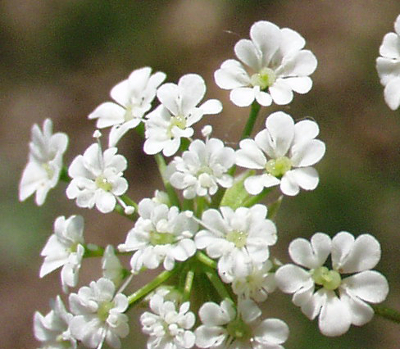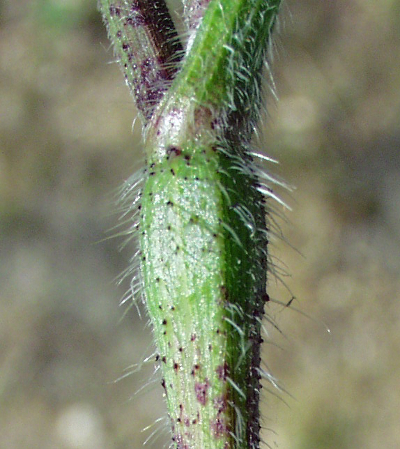Chaerophyllum |

The marginal flowers of the rough chervil are slightly enlarged and more or less deeply notched

The
stems of most Chaerophyllum species
are
swollen below the nodes
Linnaeus in his Species Plantarum used "Chaerophyllum" for the wild chervil and for the today called Chaerophyllum species. Scandix he used for the garden chervil and the burr chervil, which he listed under Scandix anthriscus. The species name was used in 1805 by Christian Hendrik Persoon to describe the genus Anthriscus, in which all chervil species are listed today.
Comprising some 40 species, the genus is widespread in Eurasia, Africa and North America. The annual, biannual or perennial, often hairy herbs possess turnip-shaped, spindle-shaped or bulbous roots and stems which are erect, branched at the base, often bristly and often thickened below the nodes. The leaves are alternate, stalked, sheathing at the base, often with bristles or hairs and 1- to 3-fold pinnate.
The inflorescences are arranged in terminal and lateral double umbels. The bracts of the umbel, the so-called involucre, is mostly missing or consists of a few leaves. The umbel possesses 4 to 25 rays and splits into "umbellules", which bearing white, yellow or blue-violet flowers. The involucel is formed from 2 to 7 usually ciliated bracts. The calix teeth are indistinct. The styles arise from a cushion-shaped stylopodium and can be longer or shorter than this. The small flowers are hermaphrodite or male, the petals are curved inward at the top.
After insect pollination the inferior ovary forms fruits that are oblong-oval, slightly flattened laterally, indistinct beaked or not. They show 10 flat, indistinct and obtuse ribs. The fruits are composed of 2 mericarps with each 5 ribs. At maturity, they turn yellow or brown.
| Floral formula: |
| * K5 C5 A5 G(2) inferior |
Chaerophyllum species are easily confused with chervil species, even Linnaeus listed the wild chervil still under Chaerophyllum. The fruits are similar, but members of the genus Anthriscus have a short but clearly separated beak under the stylopodium. Also many Chaerophyllum species are thickened below the nodes, which not occurs at the chervil.
Meaning of the species name
- temulum: formed from lat. temulentus = intoxicated and lat. tremulus = trembling (the plant causes dizziness)
Interesting notes
-
The bulbous chervil (Chaerophyllum bulbosum) can be used as wild vegetable. The tuber when cooked should remember sweet chestnuts.
-
The rough chervil (Chaerophyllum temulum) contains falcarinol, which makes the grazing animals that have eaten them stagger. Also in the hay, the plant remains toxic.